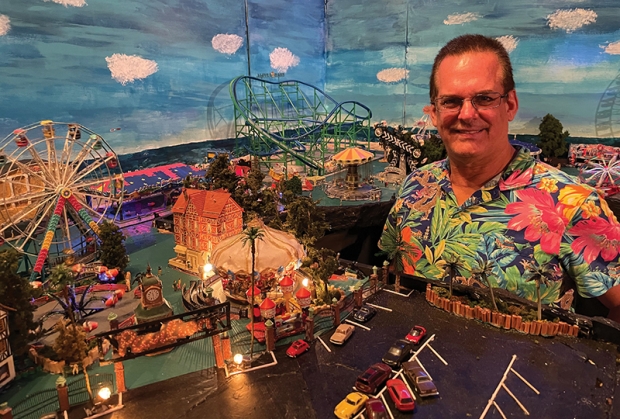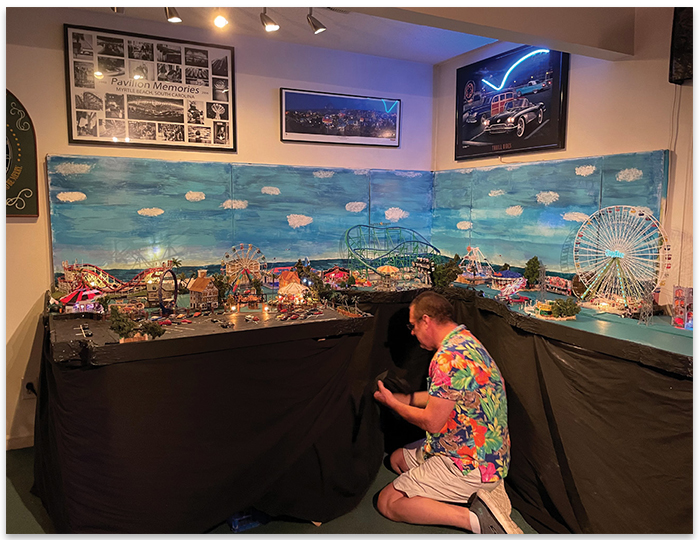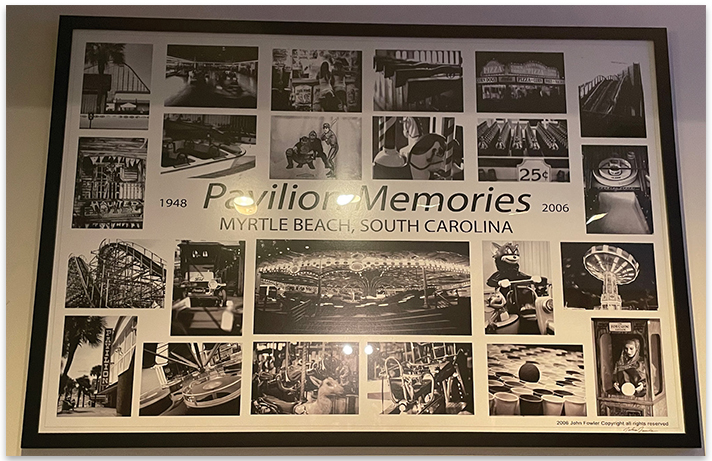Myrtle Beach man creates miniature version of former iconic amusement park

The magic starts before you even see it.
The faint sound of the chorus from “Myrtle Beach Days.” The clinking and whizzing of tiny motors spinning rides and powering bumper cars. Even a whiff of cotton candy and caramel corn.
You’re almost to the amusement park. But this time, it’s a miniature version of the legendary Myrtle Beach Pavilion Amusement Park – built with such precision and detail you might just think you’re back at the park in its heyday.
“You actually think you are there when you get up here,” Ken McMichael says.
A longtime local with fond memories of the Pavilion, McMichael combined his love for the former Myrtle Beach icon and his passion for making model rides to create the miniature replica of the park in a second-floor room of his house off Kings Highway.
The 57-year-old remembers going to the park with family as a kid and working there as a ride operator during the summers when he was a student at Myrtle Beach High School. The Pavilion, an icon of Myrtle Beach since the 1940s, closed for good after the 2006 season and was demolished. But McMichael wanted to keep those memories and magic alive – just on a smaller scale.
“It’s still sad to drive by and see that open field with the zipline,” he says. “Well, it still lasts up here.”

The miniature version has all the hallmarks of the original: The trademark Pavilion sign in cursive red letters, the arching oceanfront arcade building, ticket booths, concession stands, parked cars of patrons and smiling people. Then there’s the working rides – the Rainbow, the carousel, a haunted house, swings, roller coaster and more.
He’s dedicated to staying true to the Pavilion’s unique character, using his own memories, photos and prints of the Pavilion – some of which are displayed on the walls in his Pavilion room – to carefully craft each piece.
He orders and assembles the miniature ride models then adds the special touches that make them uniquely “Pavilion.” He’s added specific color schemes to match the original rides or glow-in-the-dark paint to capture the same essence of the original park. He has even taken on the tedious task of using teeny tiny pieces of broken mirror to build a disco ball from scratch to hang in a ride just like at the Pavilion.
“I wanted to get it as close to the real thing as I possibly could,” McMichael says. “I pretty much went by that picture [on the wall] to make sure I got it as close to detail as I could.”
It started with just a couple of rides before he set a goal of recreating the entire 11-acre amusement park. As he adds rides, he has to add on to the length of the display table. It’s gotten so large, he had to expand the room by taking over the closet to accommodate it.
Just like maintenance workers at the original Pavilion, McMichael – who is a server at Preston’s Seafood and Country Buffet, which his family owns – mainly works on his Pavilion masterpiece in the winter. Working with such small parts, he’s learned to pace himself.
“It’s just so tedious with all those parts,” he notes. “If you work on that too long, your eyes will get crossed or it will go out that second-story window.”
The rides have lights and moving parts, and some have tiny speakers for music – all powered by a hodgepodge of boxes, batteries and switches underneath the display table, hidden from view by a black curtain. It takes roughly 30 minutes for McMichael to power on all the components and bring his Pavilion to life. The display is perfectly positioned against a painted backdrop of Carolina blue sky, ocean waves and a sandy beach.
Just like the Pavilion, this miniature park is about more than just the rides. McMichael wants to truly create the amusement park atmosphere and take you there to help you again experience that magic and relive those memories.
He used old footage from the Pavilion to recreate the symphony of sounds in the amusement park – rock n’ roll music playing from one ride, beach music from another. To further stimulate your senses, he lights candles in his Pavilion room with scents such as “cotton candy” and “caramel corn” – reminiscent of those park favorites.

Guests at his holiday party a few years ago spent the entire time in the Pavilion room, mesmerized by the magic.
“I thought people were going to climb up on the board and buy ride tickets,” McMichael jokes. “They told me, ‘I think we’ll just stay up here. It feels like you are there.’”
Even strangers marveled at photos and short videos of his miniature Pavilion after he posted them in the Facebook group Myrtle Beach History.
“Gives you the feeling of being there,” Facebook user Patrick Oliver comments. “The closest we will ever come to that ever again.”
Photos of the display also impressed Jack Thompson, a local photographer who has documented Myrtle Beach history for more than half a century, including many days and events at the Pavilion.
“Wonderful and amazing… nothing like this!” he writes on Facebook. “Everyone needs to experience this fantastic creation.”
For now, there are no plans to display the miniature Pavilion publicly – it would be as tedious to move as it was to build.
McMichael has no idea how many hours and dollars he’s invested in his Pavilion – too many to count. And there’s no telling when – or if – it will ever be completely finished.
“I keep building,” he says, surveying the display as his mind ponders what addition might be next. “It’s like a never-ending process. You never really, truly finish. You keep adding on to it and changing it. It’s pretty much a labor of love for sure.”